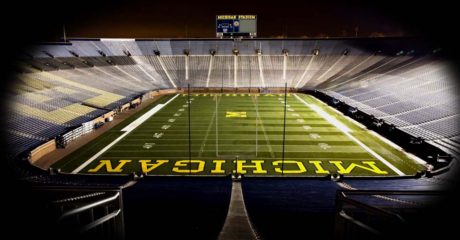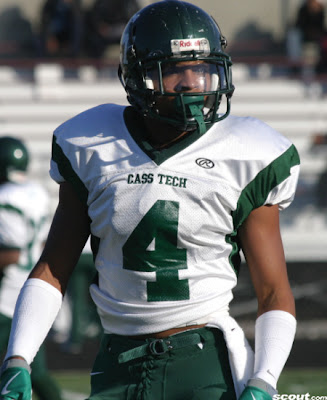
I’ve been busy this week. Between losing power on Thursday evening, not getting home until after midnight last night, and Saturday morning practice, I didn’t have a chance to write a preview for the Indiana game. But these are the games that always scare me the most. Not the Toledo or Eastern Michigan or Appalachian State games, because we win most of those and if we don’t, well, that’s just how the cookie crumbles.
No, what scare me are the games against second-rate Big Ten teams like Indiana, Northwestern, Michigan State, etc. Those games are ones that shouldn’t be huge impediments on the way to playing for a Big Ten title but too often rise up to bite you in the ass or at least make you nervous.
Today’s game was no exception. Indiana made it tough on Michigan before the Wolverines eked one out in the last couple minutes.
Offensively, Michigan frustrated me more today than at any other time this year. They seemed completely out of sync for the majority of the game. Luckily, Carlos Brown scored two early touchdowns and Tate Forcier led two late TD drives in the fourth quarter. Between those points, though, Michigan looked discombobulated.
Replacement center David Moosman had troubles snapping the ball, and both Denard Robinson and Forcier had troubles handling it. Michigan has resurrected the freeze play, where the center snaps the ball when he sees someone jump offsides. It’s supposed to earn Michigan five yards, which it did . . . once. But the freshman quarterbacks clearly aren’t prepared to run it, and neither is Moosman, since he snapped the ball one time when Indiana defensive end Greg Middleton had already got back onside. In total, it lost yards for Michigan and could end up being a turnover if, for example, the snap on the Middleton play had bounced off Forcier’s knee or facemask and ended up in the hands of a Hoosier.
The game always looks like it’s going too fast for Denard Robinson. It’s like I looked when I was little and watching my brother play Frogger; then my mom would call him to take the garbage out, I’d grab the joystick, adrenaline myself across the road, and then drown in the river. Robinson runs the ball well and has a limit of one good throw per game. He led one good drive today and made a nice throw on a seam route to Kevin Koger. After that play the coaches should have patted him on the dreadlocked head, said “Nice job,” and handed him a baseball cap (until, of course, he was needed again once Forcier got hurt).
Offensive coordinator Calvin Magee went away from the running game for a while. I have no explanation for this. Carlos Brown started the game with a 61-yard TD on a screen pass, scored a 41-yard rushing TD on the next drive, and then became a bystander for a couple quarters. We can run the ball. Our co-starters at running back, Brown and Brandon Minor, had 23 carries for 123 yards. That’s 5.3 yards per carry. But 23 carries is what ONE of those guys should have, not the combination of the two, especially when Forcier and Robinson combined for 21 rushes. The guys who earned scholarships for running the ball should run it, not the guys who earned scholarships for their throwing arms.
This is partly on Forcier as well. In my opinion, Forcier is horrible at running the read option. Even when the backside defensive end stays home to contain the quarterback, Forcier tries to make things happen on his own. He’s simply not athletic enough to make it work. Hopefully his reads will improve as he gets more and more experience. I guess the coaches have to keep calling the play to keep the defense honest, but Forcier needs to realize that the best thing about that play is the element of surprise when he keeps the ball. If I were an opposing defensive coordinator, I would tell my defensive ends, “If you stay home, this chump is going to keep the ball a couple times when he shouldn’t, and you better make him regret it.”
Defensively, it really hurts to have so little depth and experience in the defensive backfield. I thought the linebackers played better than they did last week and the defensive line did an okay job, but our defensive backfield is in shambles. Donovan Warren made one poor tackle attempt, but the Indiana didn’t want to test him much. Boubacar Cissoko was replaced early by J.T. Floyd, and neither played well. Meanwhile, strong safety Troy Woolfolk is a position-changer from cornerback who missed some tackles, and former walk-on Jordan Kovacs started at free safety and missed several assignments. Indiana took advantage of the inexperience on the back end, and you can bet that other Big Ten teams will, too. I think Michigan State will have an excellent day throwing the ball next week.
Offensive game ball goes to . . . Carlos Brown (2). He had 144 yards from scrimmage (83 rushing, 61 receiving) and two touchdowns. He ran the ball well most of the day, and what he lacks in toughness, he makes up for in home run ability.
Defensive game ball goes to . . . Jonas Mouton (1). Mouton led the team in tackles with 11 and had half a tackle for loss. He reacted slowly a couple times but he stepped up to fill a hole a couple times and made some nice hits. He didn’t have a great game, but nobody really did.
Let’s see less of this guy on offense . . . David Moosman (1). He can play guard. That’s fine. He’s a pretty good guard. In fact, with his main competition at center coming from redshirt freshman Rocko Khoury, he might well be our best center with starter David Molk out (broken foot). But I hope Molk is a quick healer. Moosman had a few bad snaps, and his quarterbacks didn’t do a great job of bailing him out.
Let’s see less of this guy on defense . . . J.T. Floyd (2). I think Cissoko re-injured his shoulder injury, but I have a hard time believing that freshmen Justin Turner and Teric Jones are significantly worse than Floyd. At this point, I have to believe the coaches are trying their best to preserve Turner’s redshirt. Jones’s has already been burned. But Floyd was responsible for at least three big plays today: 1) the missed pass break-up that ended in a big gain, 2) the 85-yard rush TD by Darius Willis in which Floyd made a poor attempt to tackle, and 3) the pass interference on the right sideline – the ball was uncatchable, but Floyd still had a hand full of jersey.






